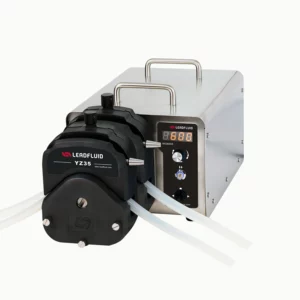Maintenance requirements for industrial peristaltic pumps are relatively low compared to other types of pumps due to their simple design and minimal contact between the pumped fluid and the pump components. However, regular maintenance is still necessary to ensure optimal performance, prevent downtime, and prolong the lifespan of the pump.
Here are some common maintenance tasks for industrial peristaltic pumps:
- Inspect Tubing: Regularly inspect the tubing for signs of wear, damage, or deterioration. Replace the tubing if any cracks, leaks, or abrasions are detected. It’s essential to use high-quality tubing compatible with the pumped fluid and operating conditions.
- Clean Pump Components: Clean the pump components, including the rollers, tubing clamps, and pump head, to remove any accumulated debris, residue, or contaminants. Use a mild detergent solution and a soft brush or cloth for cleaning, avoiding abrasive cleaners or solvents that may damage the pump.
- Check Roller Condition: Inspect the rollers for wear or damage, such as flat spots or uneven wear patterns. Replace worn or damaged rollers as needed to ensure smooth and consistent tube compression.
- Lubricate Bearings: Some industrial peristaltic pumps may have bearings that require periodic lubrication to ensure smooth operation and prevent premature wear. Refer to the manufacturer’s guidelines for lubrication intervals and recommended lubricants.
- Inspect Seals and Gaskets: Check the seals and gaskets for signs of wear, deterioration, or leaks. Replace any damaged or worn seals and gaskets to prevent fluid leakage and maintain pump integrity.
- Check Motor and Drive System: Inspect the motor and drive system for signs of wear, overheating, or abnormal noise. Ensure that the motor is properly aligned and securely mounted to the pump housing. Tighten any loose bolts or fasteners as needed.
- Calibrate Pump Settings: Periodically calibrate the pump settings, including flow rate, speed, and dispensing accuracy, to ensure accurate and consistent performance. Adjust pump parameters as necessary based on process requirements and performance feedback.
- Monitor Pump Performance: Monitor the pump performance regularly, including flow rate, pressure, and fluid delivery consistency. Keep records of performance metrics and compare them over time to identify any trends or deviations that may indicate potential issues.
- Follow Manufacturer Guidelines: Follow the manufacturer’s recommended maintenance procedures, schedules, and guidelines provided in the pump’s user manual or technical documentation. Adhering to manufacturer recommendations helps ensure safe and reliable operation of the pump.
- Training and Personnel: Provide training to personnel responsible for operating and maintaining the peristaltic pump. Ensure that operators are familiar with the pump’s operation, maintenance procedures, and safety protocols to minimize the risk of errors or accidents.
By performing regular maintenance tasks and following manufacturer guidelines, industrial peristaltic pumps can operate reliably and efficiently, contributing to uninterrupted production processes and reduced downtime. Regular maintenance helps identify and address potential issues early, prolonging the lifespan of the pump and ensuring consistent performance over time.
